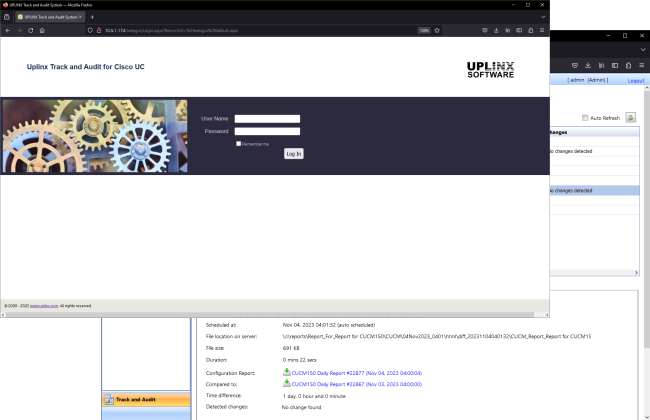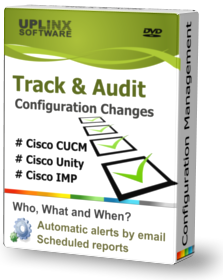UPLINX Track & Audit has been designed for enterprises that require an automated, centralized and secure solution for configuration management of Cisco Unified Communications and related servers.
Configuration and audit reports on this web-based solution can be accessed from any web browser after authentication (AD Authentication or local).

Running on Windows Server and Microsoft IIS, strong authentication with certificate-based encryption is readily available and can be configured within minutes. Domain-wide, standard-based Active Directory policies can also be applied to the Track & Audit server to enforce domain-wide security and control.
User access can be authenticated locally with a configured password or authenticated with Microsoft Active Directory. User access can be given to specific servers or report types, and all access is logged.
UPLINX Track & Audit scales up to 50 Cisco Unified Communications servers (Cisco CUCM, Unity Connection, IMP) and generates configuration and audit reports based on schedules. Cisco Audit logs are automatically gathered via FTPS from Cisco servers.
Features of UPLINX Track & Audit include:
- Centralized and secure configuration management for Cisco Unified Communications and related servers.
- Tracking and audit of configuration changes including who, what and when has changed.
- Centralized repository of configurations and audit logs for configuration management.
- Multi-cluster support up to 50 Cisco Unified Communications servers.
- Multi-user support with user access control.
- Web-based solution running on Windows Server with strong security based on certificates and encryption.
- Strong logging and auditing of access and individual actions.
- Cisco Server access is not required from each desktop running UPLINX Report Tool to view or generate reports. This enables you to firewall off all Cisco servers and allow dedicated access for the Track & Audit server. Users will only access the Track & Audit server and do not need the passwords of any Cisco servers.
- Authentication of login credentials via Active Directory means no dedicated administrative passwords need to be maintained.

